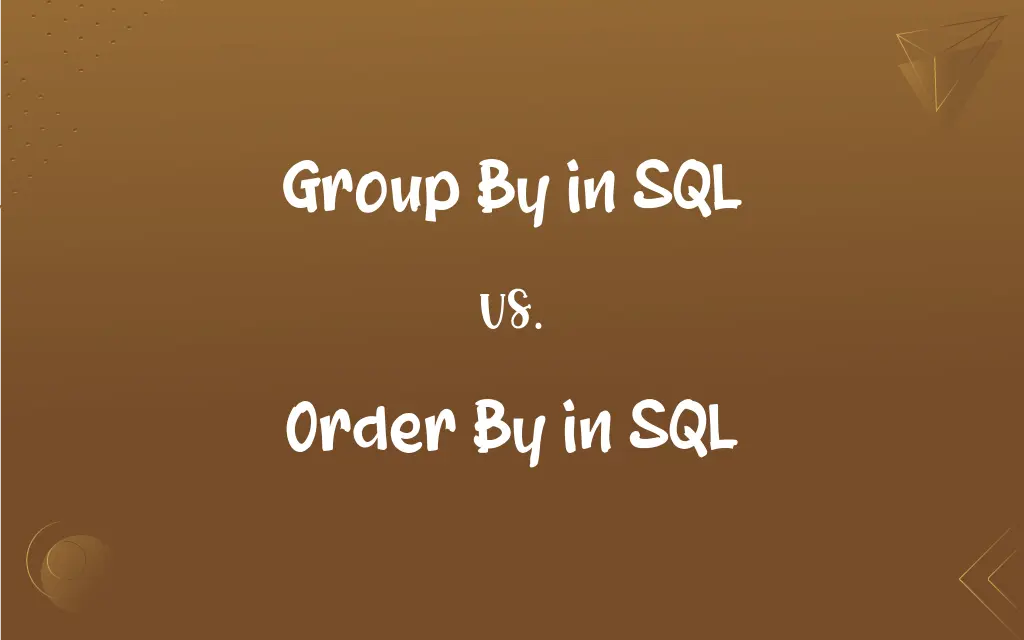Group By in SQL vs. Order By in SQL: What's the Difference?
Edited by Aimie Carlson || By Janet White || Published on February 6, 2024
GROUP BY in SQL aggregates data into groups based on one or more columns, while ORDER BY sorts the result set in either ascending or descending order.

Key Differences
GROUP BY in SQL is used to arrange identical data into groups. This command is often used with aggregate functions (COUNT, MAX, MIN, SUM, AVG) to group the result set by one or more columns. Conversely, ORDER BY is used to sort the result set in ascending or descending order. It doesn't group the data but rather orders it based on one or more columns.
GROUP BY aggregates data returned by the query, making it essential for generating summary reports from the database. For example, it can group sales by region or date. In contrast, ORDER BY does not aggregate data but simply arranges the data in a specified order, like sorting a list of customers alphabetically or by their purchase amount.
When using GROUP BY, SQL collapses the rows into a single row for each group. This is key for summarization operations on data sets. ORDER BY, on the other hand, maintains the individual rows in the result but orders them based on the specified column(s).
GROUP BY is used when the output needs to be organized into logical groups, often for analytical purposes. For instance, grouping by a category to get totals per category. ORDER BY is more about the presentation, ensuring data is displayed in a readable and ordered manner, like sorting a report by dates or names.
GROUP BY is generally used with SELECT statements that involve aggregate calculations. It helps in breaking down complex data sets into manageable chunks. ORDER BY is more versatile, being used in various SELECT queries where the order of the results is important, but without changing the nature of the data presented.
ADVERTISEMENT
Comparison Chart
Purpose
Aggregates data into groups.
Sorts the result set.
Function
Used with aggregate functions for summarization.
Used to arrange data in ascending or descending order.
Result
Creates groups of rows with common values.
Maintains individual rows, orders them based on a column.
Use Case
For generating summary reports.
For presenting data in a readable order.
Impact on Data
Changes the structure of the result set by grouping.
Does not change the structure, only the order of rows.
ADVERTISEMENT
Group By in SQL and Order By in SQL Definitions
Group By in SQL
GROUP BY enables aggregate functions on groups of rows.
SELECT Department, AVG(Salary) FROM Employees GROUP BY Department;
Order By in SQL
ORDER BY sorts the result set of a query in either ascending or descending order.
SELECT Name, Age FROM Students ORDER BY Age DESC;
Group By in SQL
GROUP BY works with SELECT to organize the output into groups.
SELECT Manufacturer, COUNT(*) FROM Products GROUP BY Manufacturer;
Order By in SQL
ORDER BY arranges rows based on specified column values.
SELECT EmployeeName, Salary FROM Employees ORDER BY Salary;
Group By in SQL
GROUP BY is essential for generating grouped data summaries.
SELECT Date, COUNT(OrderID) FROM Orders GROUP BY Date;
Order By in SQL
ORDER BY is often the last clause in a SELECT statement.
SELECT ProductName, Price FROM Products ORDER BY Price ASC;
Group By in SQL
GROUP BY is used to group rows that have the same values in specified columns.
SELECT COUNT(CustomerID), Country FROM Customers GROUP BY Country;
Order By in SQL
ORDER BY can sort data alphabetically, numerically, or by date.
SELECT Name, JoinDate FROM ClubMembers ORDER BY JoinDate DESC;
Group By in SQL
GROUP BY clusters data into subgroups within a table.
SELECT Type, SUM(Amount) FROM Transactions GROUP BY Type;
Order By in SQL
ORDER BY is used for sorting query results for better readability.
SELECT Title FROM Books ORDER BY Title ASC;
FAQs
Does GROUP BY affect the number of rows returned?
Yes, it consolidates rows into groups, potentially reducing the number of rows.
What types of columns can be used with ORDER BY?
Any column, whether numeric, string, or date, can be used for sorting.
What does GROUP BY do in SQL?
It groups rows with identical values in specified columns, often for aggregation.
How does ORDER BY handle NULL values?
NULL values are treated as the lowest possible values and sorted accordingly.
Does ORDER BY change the data in the database?
No, it only changes the order of rows in the query result, not the database.
What is the purpose of ORDER BY in SQL?
To sort the results of a query in ascending or descending order.
Can GROUP BY and ORDER BY be used in the same query?
Yes, they can be used together for grouping and then sorting the results.
Is GROUP BY necessary with aggregate functions?
Yes, when summarizing data across multiple groups, GROUP BY is essential.
Can ORDER BY sort by multiple columns?
Yes, you can specify multiple columns for sorting in the ORDER BY clause.
Can GROUP BY be used without an aggregate function?
While possible, it's not common or useful without an aggregate function.
Can GROUP BY work with multiple columns?
Yes, GROUP BY can group data based on multiple columns.
Does GROUP BY limit the selection of columns?
Yes, only the grouping columns and aggregated columns can be selected.
What is the default sort order in ORDER BY for multiple columns?
The default is ascending for each specified column.
What happens if you don't specify ORDER BY?
The order of the rows in the result set will be unpredictable.
Is ORDER BY ascending or descending by default?
By default, ORDER BY sorts data in ascending order.
Is GROUP BY mandatory in SQL?
No, it's only used when you need to group and summarize data.
Can you use aliases in the GROUP BY clause?
Yes, column aliases defined in the SELECT can be used in GROUP BY.
How do you sort in descending order with ORDER BY?
By using the DESC keyword after the column name in the ORDER BY clause.
Can ORDER BY sort alphabetically?
Yes, it can sort string data alphabetically.
Can GROUP BY and ORDER BY use expressions or functions?
Yes, both can use expressions or functions on the columns specified.
About Author
Written by
Janet WhiteJanet White has been an esteemed writer and blogger for Difference Wiki. Holding a Master's degree in Science and Medical Journalism from the prestigious Boston University, she has consistently demonstrated her expertise and passion for her field. When she's not immersed in her work, Janet relishes her time exercising, delving into a good book, and cherishing moments with friends and family.
Edited by
Aimie CarlsonAimie Carlson, holding a master's degree in English literature, is a fervent English language enthusiast. She lends her writing talents to Difference Wiki, a prominent website that specializes in comparisons, offering readers insightful analyses that both captivate and inform.







































































